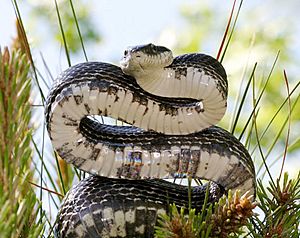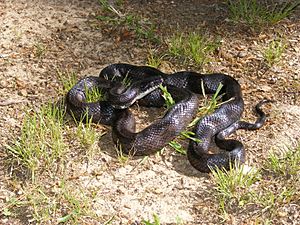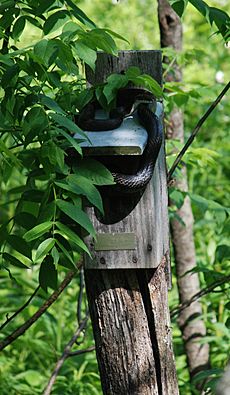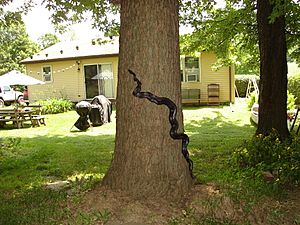Pantherophis obsoletus facts for kids
Quick facts for kids Pantherophis obsoletus |
|
|---|---|
 |
|
| Conservation status | |
| Scientific classification | |
| Genus: |
Pantherophis
|
| Species: |
obsoletus
|
| Synonyms | |
|
|
The western rat snake (Pantherophis obsoletus) is a common snake found in central North America. People also call it the black rat snake or just black snake. This snake is not venomous, meaning it is not poisonous. It belongs to a group of snakes called Colubridae.
Sometimes, people confuse it with other black snakes like the Eastern indigo snake or the Eastern racer. The western rat snake can have different colors, including a type known as the Texas ratsnake.
Contents
Where Western Rat Snakes Live
The western rat snake lives in the central part of the United States. You can find it west of the Mississippi River. Its home range stretches from eastern and southern Iowa down through Missouri and Arkansas. It also lives in western Louisiana, eastern Texas, Oklahoma, eastern Kansas, and southeastern Nebraska.
While many western rat snakes are black or have black patches, some have special color variations. For example, the Texas rat snake is a brown to black type. It often has hints of orange or red. This variant is found in southern Oklahoma, Texas, and Louisiana.
Western Rat Snake Habitats
Western rat snakes can live in many different places. Some of their habitats even overlap. These snakes are amazing climbers and spend a lot of time in trees. They can live in rocky hillsides or flat farmlands.
They especially like areas with lots of trees. They are known for being excellent climbers. They can even climb up the trunk of large trees without any branches to help them. These snakes are also good swimmers.
In winter, they go into dens to hibernate. They sometimes share these dens with other snakes like copperheads and timber rattlesnakes. This is why one of their old names was "pilot black snake." People used to think this non-venomous snake led the venomous ones to their dens.
What Western Rat Snakes Look Like

Adult western rat snakes can grow very long. They are usually between 106.5 and 183 centimeters (about 3.5 to 6 feet) long. They are the longest snakes found in Canada. The longest one ever recorded was 256.5 centimeters (about 8.4 feet) long. This makes it officially the longest snake in North America.
Adult western rat snakes are shiny black on top. They have white lips, chin, and throat. Sometimes, you can still see faint patterns from when they were young. This is especially true when their skin stretches after a big meal.
Young western rat snakes look very different. They have strong patterns with brown blotches on a gray background. They look a bit like miniature fox snakes. As they grow, their skin quickly gets darker.
Common Names for the Western Rat Snake
People use many different names for this snake. Some common names include:
- black chicken snake
- black coluber
- chicken snake
- mountain black snake
- mountain pilot snake
- pilot
- rat snake
- rusty black snake
- scaly black snake
- cow snake
- schwartze Schlange (German for "black snake")
- sleepy John
- white-throated racer
Western Rat Snake Behavior
When they are young, many animals hunt western rat snakes. This includes other snakes. Once they grow up, they can still be hunted by animals like American minks and large birds of prey. red-tailed hawks are especially known to hunt them.
When a western rat snake is surprised, it might freeze. It can also wrinkle its body into a series of kinks. If it feels more threatened, it might quickly slither away. It can also vibrate its tail. This can make it sound like a rattlesnake, which helps scare away predators.
Western rat snakes can also release a bad-smelling musk. They will do this if someone picks them up. They spread the musk with their tails to try and make the threat go away. If a black snake is cornered or bothered, it might stand its ground. It can even become aggressive.
Large snakes, over 150 centimeters (about 5 feet) long, sometimes fight back against big birds of prey. These fights can be long and violent. The black rat snake is very agile and strong. It can sometimes overpower and even kill powerful birds like red-tailed hawks, great horned owls, and red-shouldered hawks. However, in many cases, the bird kills the snake, or both animals might die.
What Western Rat Snakes Eat
The western rat snake is a constrictor. This means it squeezes its prey until the animal cannot breathe or its heart stops. It coils around small animals and tightens its grip. Then, it eats them.
They often eat mice, voles, and rats. But they are not picky eaters. They will eat almost any small animal they can catch. This can include other snakes (even their own kind), frogs, lizards, chipmunks, squirrels, young rabbits, young opossums, songbirds, and bird eggs. One snake was seen eating a whole nest of Mallard eggs.
Snakes often target birds that nest in holes or cavities. The rat snake is known as a top predator at purple martin colonies. A single large snake can eat many eggs, baby birds, and even adult birds each summer. People have tried different ways to keep rat snakes away from martin houses, but they don't always work well.
Western Rat Snake Reproduction and Life Cycle
Western rat snakes usually mate in late May and early June. The male snake wraps its tail around the female's tail. Their vents (where their bodies open) are almost touching. The male then uses one of its sex organs, called a hemipenis, to mate with the female. Mating can last from a few minutes to several hours.
About five weeks later, the female lays 12 to 20 eggs. These eggs are about 36 to 60 millimeters (1.4 to 2.4 inches) long. They are also about 20 to 26.5 millimeters (0.8 to 1 inch) wide. The eggs hatch about 65 to 70 days later, usually in late August to early October. The baby snakes are about 28 to 41 centimeters (11 to 16 inches) long. They look like tiny fox snakes when they are born.
Western Rat Snakes as Pets
Western rat snakes are popular pets. This is because they are a good size, usually calm, and easy to care for. They also come in many different color types. Some can be leucistic (mostly white), albino (white with red eyes), or even scaleless.
They like to hide and burrow. People who keep them as pets usually give them loose bedding. This can be wood shavings or newspaper. They also need one or more hide boxes. Pet rat snakes are usually fed mice that have been killed or stunned. This is safer for the snake. It also prevents the snake from getting sick from wild mice.
Images for kids
Pantherophis obsoletus at the TIGR Reptile Database. Accessed 2 June 2008.
See also
 In Spanish: Víbora ratonera para niños
In Spanish: Víbora ratonera para niños






